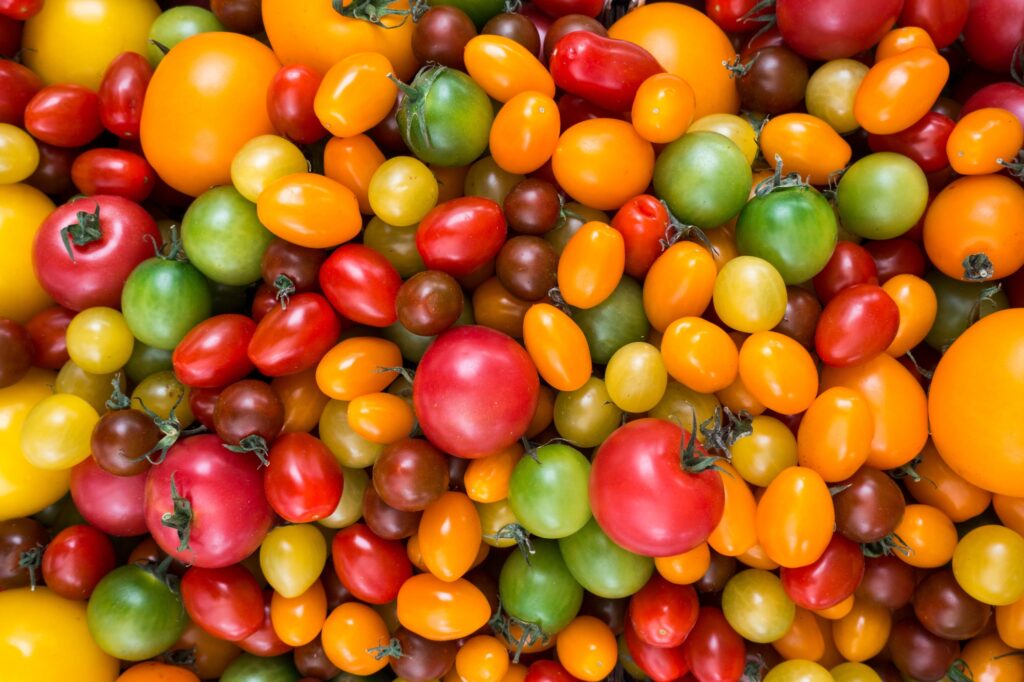25 Fun Facts About Tomatoes

Introduction
Tomatoes are one of the most popular fruits in the world. Though commonly considered a vegetable, tomatoes are technically a fruit as they contain seeds and develop from the ovary of a flowering plant. For centuries, tomatoes have been a beloved ingredient across many cuisines. Their versatility, flavor, and nutritional value make them a staple in kitchens worldwide.
The tomato belongs to the nightshade family, whose scientific name is Solanaceae ((https://en.wikipedia.org/wiki/Solanaceae)). The botanical name of the cultivated tomato is Solanum lycopersicum. Tomatoes originated in South America, likely Peru, Bolivia, and Ecuador, and grew wild in the Andean mountains.
Around 500 BC, tomatoes were domesticated by the Aztecs in Mexico, who started cultivating them as a food crop. The Aztecs used tomatoes in their cooking and even regarded tomato seeds as aphrodisiacs.
Spanish conquistadors introduced tomatoes to Europe upon their return from Mexico in the early 16th century. From Spain, tomatoes spread through Europe and beyond, becoming a global sensation and dietary staple.
Today, there are over 10,000 known varieties of tomatoes, ranging from beefsteak and cherry to heirloom and grape tomatoes. Their global popularity stems not only from their incredible taste but also their nutritional value.
Nutrition Facts

- Tomatoes are packed with nutrients but low in calories – one medium raw tomato has about 25 calories.
- Tomatoes are an excellent source of vitamin C, containing 28% of the recommended daily intake in a medium tomato.
- They also provide vitamin K, potassium, folate, and vitamin B6. Tomatoes contain all four major carotenoids: alpha-carotene, beta-carotene, lutein, and lycopene.
- The vibrant red color of tomatoes comes from lycopene, a powerful antioxidant. Tomatoes account for 80% of the lycopene in the American diet.
- Cooking tomatoes actually increases lycopene absorption by breaking down cell walls to make it more bioavailable.
Health Benefits

- Eating tomatoes may help lower cholesterol levels and blood pressure due to their combination of fiber, potassium, vitamin C, and lycopene1.
- Studies show that higher consumption of tomatoes correlates with a lower risk of cardiovascular disease, especially in men.
- The antioxidants in tomatoes, especially lycopene, may help protect skin from sun damage by scavenging harmful free radicals.
- Tomatoes contain chlorogenic acid and naringenin, antioxidants that exhibit anti-inflammatory activities in the body.
- Tomatoes may lower the risk of various cancers, including prostate, lung, stomach, and colorectal cancers, likely due to their high antioxidant content.
- Lycopene from tomatoes has been shown to inhibit cancer cell growth and spread in multiple studies.
- Eating tomatoes may help reduce macular degeneration due to their lutein and zeaxanthin content, which help protect the eyes.
History & Origins

- Tomatoes originated in the Andean mountains of South America, likely modern-day Peru, Bolivia, Chile, and Ecuador.
- The Aztecs in Mexico were the first to domesticate and cultivate tomatoes around 500 BC, using them in cooking.
- Spanish conquistador Hernán Cortés brought tomato seeds back to Europe after conquering the Aztec empire in 15212.
- Italians initially grew tomatoes purely for ornamental purposes and avoided eating them. Tomatoes were once called “golden apples” in Italy.
- Europeans initially avoided eating tomatoes, fearing they were poisonous like deadly nightshade.
- Tomatoes were first cultivated in Britain and the American colonies in the 18th century after overcoming fears of toxicity.
- Thomas Jefferson helped popularize tomatoes in America after discovering them in Paris. He grew tomatoes at Monticello starting in 17813.
- The pizza Margherita, featuring tomatoes, mozzarella, and basil, was invented in Naples, Italy in 1889 – increasing tomato popularity.
Tomato Varieties

- There are over 10,000 known varieties of tomatoes worldwide, including beefsteak, oxheart, cherry, grape, heirloom, and more4.
- Popular heirloom tomatoes include Brandywine, Black Krim, Green Zebra, Cherokee Purple, and Mortgage Lifter.
- Determinate tomatoes, or “bush tomatoes”, are more compact, mature early, and produce all their fruit around the same time.
- Indeterminate tomatoes continue to grow, flower and produce fruit all season long until killed by frost.
- Cherry tomatoes are small, round tomatoes with high sugar content that grows in clusters on vines. They come in standard red as well as yellow, orange, purple, and black varieties.
FAQ

Are tomatoes a fruit or a vegetable?
Tomatoes are technically a fruit because they contain seeds and develop from the ovary of a flowering plant. However, they are commonly used as a vegetable in culinary contexts due to their savory flavor profile.
What are the nutritional benefits of eating tomatoes?
Tomatoes are low in calories but high in nutrients, providing a good source of vitamins C and K, potassium, folate, and vitamin B6. They also contain essential carotenoids like lycopene, which contribute to their health benefits.
Can cooking tomatoes affect their nutritional value?
Yes, cooking tomatoes can actually enhance their nutritional value. Heat breaks down the tomatoes’ cell walls, making the lycopene they contain more bioavailable, which increases its absorption by the body.
What are some health benefits of tomatoes?
Consuming tomatoes may help lower cholesterol levels and blood pressure, protect the skin from sun damage, reduce the risk of certain cancers, and help prevent macular degeneration due to their antioxidant properties.
How many varieties of tomatoes are there?
There are over 10,000 known varieties of tomatoes, ranging from large beefsteak tomatoes to small cherry and grape tomatoes, including many heirloom varieties with unique flavors and appearances.
Conclusion
Tomatoes are one of the most diverse, popular, and nutritious fruits in the world, offering an array of health benefits. Their origin can be traced to the Andes Mountains of South America, and they were first cultivated by the Aztecs in Mexico. Though initially met with skepticism in Europe, the tomato overcame fears of toxicity to become a beloved global food. With over 10,000 varieties to choose from, tomatoes can be enjoyed in endless ways. Their rich history and nutrition profile have solidified the tomato as an essential fruit in kitchens and gardens worldwide.
- Tomatoes 101: Nutrition Facts and Health Benefits,https://www.healthline.com/nutrition/foods/tomatoes [↩]
- The History of the Arrival of the Tomato in Europe: https://traditom.eu/project/history/ [↩]
- 4 Foods Jefferson Helped Popularize in America, https://www.monticello.org [↩]
- More Than 10,000 Varieties Of Tomatoes. Which One Are You Eating? – https://altifarm.com/ [↩]





